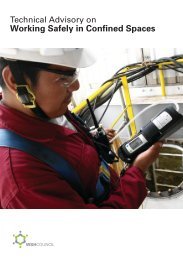HERE - Workplace Safety and Health Council
HERE - Workplace Safety and Health Council
HERE - Workplace Safety and Health Council
You also want an ePaper? Increase the reach of your titles
YUMPU automatically turns print PDFs into web optimized ePapers that Google loves.
3.5 Vertical LifelinesThere are basically two types of vertical lifeline (VLL) designs which are classified as eitherpermanent or temporary.3.5.1 Permanent Vertical LifelineA permanent VLL is defined as a tensioned line whichis permanently fastened to at least one position at itsupper end, to act as a reliable anchor point.3.5.2 Temporary Vertical LifelineA temporary VLL is defined as a suspended line thatis temporarily fastened at its upper extremity to anoverhead anchoring point, to which a sliding-type fallarrester can be attached.Temporary VLLs shall comprise the following designcriteria (see Table 5):Permanent VLLs shall comprise the following designcriteria (see Table 4):Figure 13: Permanent VLL.Figure 14: Temporary VLL.Design Criteria• Capable of being fastened to a ladder or structure at the upper <strong>and</strong> lower extremity. Anumber of brackets at intervals should be installed, if required, as per recommended bythe manufacturer.• Capable of being tensioned, once installed, as per recommended by the manufacturer.• Allow the sliding-type fall arrester to be attached <strong>and</strong> detached at points along thelifeline, unless the sliding-type fall arrester is designed to be integrated as a wholesystem.• Permit the movement of the sliding-type fall arrester in an upward or downwarddirection without impeding movement, especially at intermediate fastenings.• Prevent unintentional separation of the fall arrester from the lifeline.Table 4: Design criteria for permanent VLLs.Design Criteria• Capable of being fastened to an overhead anchoring point in accordance with therecommendation by the manufacturer.• Able to allow the sliding-type fall arrester to be attached <strong>and</strong> detached at least at the lowerextremity of the lifeline, unless the sliding-type fall arrester is designed to be integral.• Allow the movement of the sliding-type fall arrester in an upward <strong>and</strong> downwarddirection, without impeding movement.• Capable of being fitted with a tensioning weight or other stabilizing means at the lowerextremity.• Prevent unintentional separation of the fall arrester from the lifeline.Table 5: Design criteria for temporary VLLs.20 21
















